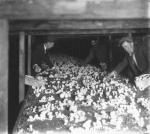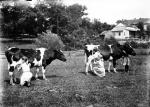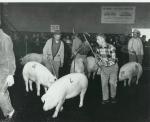Chapter One: Grown in Pennsylvania
Pennsylvania agriculture is very diverse. The Commonwealth is a major producer of beef, dairy animals and dairy products, poultry and eggs, and honey. Important crops include food grains, grain and forage for livestock, tobacco, soy beans, crops raised for vegetable oil, garden vegetables, a wide variety of fruit and nuts, mushrooms, and nursery plants.
In 2004, Pennsylvania led the nation in the production of mushrooms; it was second in the production of eggs and layers, third in the production of Christmas trees, and fifth in the production of grapes, orchard fruits, milk, ice cream, and pumpkins.
While farms and gardens can be found in every county in the state, some are more notable as agricultural producers than others. Lancaster County leads the state and ranks second in the nation in agricultural production. With the most farms in the nation, it is the leading producer of beef cattle, pullets, broiler and layer hens, eggs, hogs, milk, turkeys, horses, milk cows, and tobacco.
Lancaster County leads the state and ranks second in the nation in agricultural production. With the most farms in the nation, it is the leading producer of beef cattle, pullets, broiler and layer hens, eggs, hogs, milk, turkeys, horses, milk cows, and tobacco.  Adams County is a major center of fruit orchards, especially apples and peaches. Home to a number of commercial dairies and oat growers,
Adams County is a major center of fruit orchards, especially apples and peaches. Home to a number of commercial dairies and oat growers,  Somerset County is best known for its maple syrup, which early settlers to the region learned to make from the Native Americans.
Somerset County is best known for its maple syrup, which early settlers to the region learned to make from the Native Americans.
Native Americans, in what would become Pennsylvania, practiced agriculture for centuries before the arrival of Europeans. By the eleventh century, they had developed a high-yield system of slash and burn farming. Creating fields by clearing brush, and girdling and burning trees to let the sun reach the soil, they then planted beans, corn, and squash together - a method of planting that was advantageous to the crops and the people. Beans climbed up the cornstalks and fixed nitrogen in the soil that fertilized the corn and squash. The resulting network of roots and tendrils inhibited weed growth and helped to retain moisture in the soil. Beans, corn, and squash - better known to the Indians as the Three Sisters - provided a very nutritious diet that was high in amino acids, fiber, protein, and vitamins.
Many of the first European settlers, who arrived in the early seventeenth century, survived only with the assistance of Native American farmers, from whom they learned how to cultivate New World beans, corn, pumpkins (or "pompions" as some of the Europeans called them), and squash. Lenape horticulturists, like those who lived in what the newcomers called "Minguannan Indian Town," provided many of the early settlers with produce from their gardens.
"Minguannan Indian Town," provided many of the early settlers with produce from their gardens.
In the 1700s tens of thousands of immigrants flooded Pennsylvania and forced the Lenape off their lands, which the newcomers took up and began to farm. Wheat was one of the main crops of southeast Pennsylvania and in fact, Penn's colony became the breadbasket of colonial America. Wheat and flour produced here were shipped to Africa, the Caribbean Islands, and Europe. In a short time, Pennsylvania also became famous for other crops.
newcomers took up and began to farm. Wheat was one of the main crops of southeast Pennsylvania and in fact, Penn's colony became the breadbasket of colonial America. Wheat and flour produced here were shipped to Africa, the Caribbean Islands, and Europe. In a short time, Pennsylvania also became famous for other crops.
European settlers were fascinated by the plants and animals of North America and were always in search of new and useful plants, both edible and ornamental. On the banks of the Schuylkill River outside of Philadelphia, John Bartram established the most famous botanical gardens of British North America in the 1730s. Here he planted and cultivated the plants that he gathered on his many journeys through eastern woods and fields. In the 1700s Philadelphia became the scientific and horticultural center of British North America and the new nation. Botanist
John Bartram established the most famous botanical gardens of British North America in the 1730s. Here he planted and cultivated the plants that he gathered on his many journeys through eastern woods and fields. In the 1700s Philadelphia became the scientific and horticultural center of British North America and the new nation. Botanist  Benjamin Smith Barton wrote the first major study of American medicinal plants. William Hamilton cultivated the first seeds and cuttings brought back from the Lewis and Clark expedition in the famous gardens of his
Benjamin Smith Barton wrote the first major study of American medicinal plants. William Hamilton cultivated the first seeds and cuttings brought back from the Lewis and Clark expedition in the famous gardens of his  Woodland estate.
Woodland estate.
Apples were critical to colonial people's "competency" - the variety of products that furnished a comfortable living. In the colonial period it was almost impossible to find a farm without an orchard. Apples stored well, so farm families kept them over the wintertime and also fed the fruit to their livestock. Early Delaware Valley farmers were less famous for their apples than for products from their fruit - cider and the potent alcoholic beverage derived from cider known by such names as "apple brandy" or "apple jack."
Swedish settlers were renowned in Pennsylvania and neighboring colonies for brandy they made from apples and from peaches, pears, and other fruits. Pennsylvanians" fondness for apple cider and brandy also was beneficial to many people settling on the western frontier. In the 1790s, John Chapman, better known as "Johnny Appleseed," gathered apple seeds from cider mills in the east and then planted nurseries in the western parts of the state. He sold and gave away thousands of young apple trees to farmers settling in Ohio and beyond. In the early 1800s, York County orchardist Jonathan Jessop cultivated the
"Johnny Appleseed," gathered apple seeds from cider mills in the east and then planted nurseries in the western parts of the state. He sold and gave away thousands of young apple trees to farmers settling in Ohio and beyond. In the early 1800s, York County orchardist Jonathan Jessop cultivated the  York Imperial Apple, which was best known for its great flavor that actually improved in storage.
York Imperial Apple, which was best known for its great flavor that actually improved in storage.
In 1797, Irish immigrant John Gilkey settled in Lawrence County and cultivated the Neshannock Potato, a new variety that achieved wide popularity in the nineteenth century. Like apples, potatoes were critical to the survival of farmers and their families. Spuds kept well over the winter months and were vitamin packed. They also figured prominently in crop rotation schemes and were used as animal feed for cattle and pigs.
Neshannock Potato, a new variety that achieved wide popularity in the nineteenth century. Like apples, potatoes were critical to the survival of farmers and their families. Spuds kept well over the winter months and were vitamin packed. They also figured prominently in crop rotation schemes and were used as animal feed for cattle and pigs.
From the earliest days of European settlement, Pennsylvania farm families raised a great variety of plants and animals. Men, women, and children worked together to produce foods for their own consumption and for barter and sale. In the nineteenth century, women generally took care of the poultry, swine, cows, and other livestock. Home butter making and cheese making were important sources of farm income.
Home butter making and cheese making were important sources of farm income.
Pigs were the settlers' favorite livestock for many different reasons. Roaming freely in the countryside and woods, they practically cared for themselves, ate virtually anything, produced large numbers of offspring, and provided both meat and lard for cooking fat. In the early 1800s, Pennsylvania farmers joined the emerging movement to improve American livestock through selective breeding. On his Chester County farm, James Jefferis developed the Chester White, a larger and more distinctive breed of hog that gained weight fast in pens on a diet of grain, fruit, potatoes, and household scraps.
Chester White, a larger and more distinctive breed of hog that gained weight fast in pens on a diet of grain, fruit, potatoes, and household scraps.
The transportation revolution of the early 1800s accelerated the rise of commercial farming across the state. The Pennsylvania Conestoga wagon became the great overland freight hauler of the era. Paved roads, canals, and railroads gave previously isolated farmers access to a growing network of local and regional farmer markets and to markets across the nation and the world. Harrisburg's
Conestoga wagon became the great overland freight hauler of the era. Paved roads, canals, and railroads gave previously isolated farmers access to a growing network of local and regional farmer markets and to markets across the nation and the world. Harrisburg's  Market Square, for example, became the prime destination for farmers who lived in Cumberland, Dauphin, Lebanon, and Perry counties. Completed in 1794, the
Market Square, for example, became the prime destination for farmers who lived in Cumberland, Dauphin, Lebanon, and Perry counties. Completed in 1794, the  Philadelphia and Lancaster Turnpike, the first macadamized road in the country, enabled Lancaster farmers to sell more of their produce in Philadelphia markets.
Philadelphia and Lancaster Turnpike, the first macadamized road in the country, enabled Lancaster farmers to sell more of their produce in Philadelphia markets.
During the American Civil War, the nation's food distribution networks expanded to provide the huge volume of food needed to feed soldiers in the field. Pennsylvania's considerable contributions to the war effort - agricultural products, manufactured goods, and men - all traveled by way of the Commonwealth's railroads. In 1875, Pittsburgh businessman Henry J. Heinz started a food processing business that mass-produced horseradish, ketchup, pickles, relish, and vinegar of a consistently high quality - all made from grain, fruits, and vegetables grown in Pennsylvania. By 1900 the H. J. Heinz Corporation was the nation's largest food processor.
Henry J. Heinz started a food processing business that mass-produced horseradish, ketchup, pickles, relish, and vinegar of a consistently high quality - all made from grain, fruits, and vegetables grown in Pennsylvania. By 1900 the H. J. Heinz Corporation was the nation's largest food processor.
Across Pennsylvania and America, farmers planted kitchen and herb gardens, orchards and vast fields, with seeds they saved from the previous year's crops. These plants were descendants of fruits, herbs, and vegetables that family members had grown and passed down for generations. While Heinz was hard at work introducing American diners to better quality pickles, Doylestown farmer W. Atlee Burpee was introducing American diners and gardeners to better quality cucumbers through his seed catalog. In 1878, Burpee began to sell vegetable and flower seeds from his own garden through the mail. Testing the seeds he offered for sale on his Bucks County farm, he created new varieties through careful cross pollination that are still grown in gardens and served in restaurants around the world.
W. Atlee Burpee was introducing American diners and gardeners to better quality cucumbers through his seed catalog. In 1878, Burpee began to sell vegetable and flower seeds from his own garden through the mail. Testing the seeds he offered for sale on his Bucks County farm, he created new varieties through careful cross pollination that are still grown in gardens and served in restaurants around the world.
In the twentieth century, the explosive growth of cities and towns in the Northeast, and industrialization of agriculture brought new opportunities and challenges to Pennsylvania farmers. Gasoline-powered farm machinery, hybrid plants, chemical fertilizers, and other technological and scientific innovations transformed farming. Fluid milk and poultry production emerged as major industries, while consumer demand for fresh, locally-grown produce helped Pennsylvania agriculture remain the state's leading industry.
In 2004, Pennsylvania led the nation in the production of mushrooms; it was second in the production of eggs and layers, third in the production of Christmas trees, and fifth in the production of grapes, orchard fruits, milk, ice cream, and pumpkins.
While farms and gardens can be found in every county in the state, some are more notable as agricultural producers than others.
Native Americans, in what would become Pennsylvania, practiced agriculture for centuries before the arrival of Europeans. By the eleventh century, they had developed a high-yield system of slash and burn farming. Creating fields by clearing brush, and girdling and burning trees to let the sun reach the soil, they then planted beans, corn, and squash together - a method of planting that was advantageous to the crops and the people. Beans climbed up the cornstalks and fixed nitrogen in the soil that fertilized the corn and squash. The resulting network of roots and tendrils inhibited weed growth and helped to retain moisture in the soil. Beans, corn, and squash - better known to the Indians as the Three Sisters - provided a very nutritious diet that was high in amino acids, fiber, protein, and vitamins.
Many of the first European settlers, who arrived in the early seventeenth century, survived only with the assistance of Native American farmers, from whom they learned how to cultivate New World beans, corn, pumpkins (or "pompions" as some of the Europeans called them), and squash. Lenape horticulturists, like those who lived in what the newcomers called
In the 1700s tens of thousands of immigrants flooded Pennsylvania and forced the Lenape off their lands, which the
European settlers were fascinated by the plants and animals of North America and were always in search of new and useful plants, both edible and ornamental. On the banks of the Schuylkill River outside of Philadelphia,
Apples were critical to colonial people's "competency" - the variety of products that furnished a comfortable living. In the colonial period it was almost impossible to find a farm without an orchard. Apples stored well, so farm families kept them over the wintertime and also fed the fruit to their livestock. Early Delaware Valley farmers were less famous for their apples than for products from their fruit - cider and the potent alcoholic beverage derived from cider known by such names as "apple brandy" or "apple jack."
Swedish settlers were renowned in Pennsylvania and neighboring colonies for brandy they made from apples and from peaches, pears, and other fruits. Pennsylvanians" fondness for apple cider and brandy also was beneficial to many people settling on the western frontier. In the 1790s, John Chapman, better known as
In 1797, Irish immigrant John Gilkey settled in Lawrence County and cultivated the
From the earliest days of European settlement, Pennsylvania farm families raised a great variety of plants and animals. Men, women, and children worked together to produce foods for their own consumption and for barter and sale. In the nineteenth century, women generally took care of the poultry, swine, cows, and other livestock.
Pigs were the settlers' favorite livestock for many different reasons. Roaming freely in the countryside and woods, they practically cared for themselves, ate virtually anything, produced large numbers of offspring, and provided both meat and lard for cooking fat. In the early 1800s, Pennsylvania farmers joined the emerging movement to improve American livestock through selective breeding. On his Chester County farm, James Jefferis developed the
The transportation revolution of the early 1800s accelerated the rise of commercial farming across the state. The Pennsylvania
During the American Civil War, the nation's food distribution networks expanded to provide the huge volume of food needed to feed soldiers in the field. Pennsylvania's considerable contributions to the war effort - agricultural products, manufactured goods, and men - all traveled by way of the Commonwealth's railroads. In 1875, Pittsburgh businessman
Across Pennsylvania and America, farmers planted kitchen and herb gardens, orchards and vast fields, with seeds they saved from the previous year's crops. These plants were descendants of fruits, herbs, and vegetables that family members had grown and passed down for generations. While Heinz was hard at work introducing American diners to better quality pickles, Doylestown farmer
In the twentieth century, the explosive growth of cities and towns in the Northeast, and industrialization of agriculture brought new opportunities and challenges to Pennsylvania farmers. Gasoline-powered farm machinery, hybrid plants, chemical fertilizers, and other technological and scientific innovations transformed farming. Fluid milk and poultry production emerged as major industries, while consumer demand for fresh, locally-grown produce helped Pennsylvania agriculture remain the state's leading industry.















